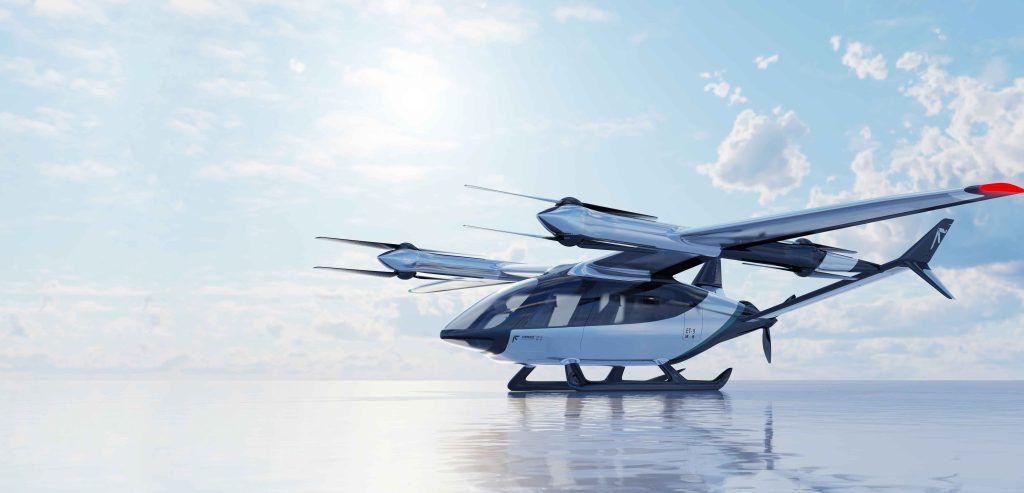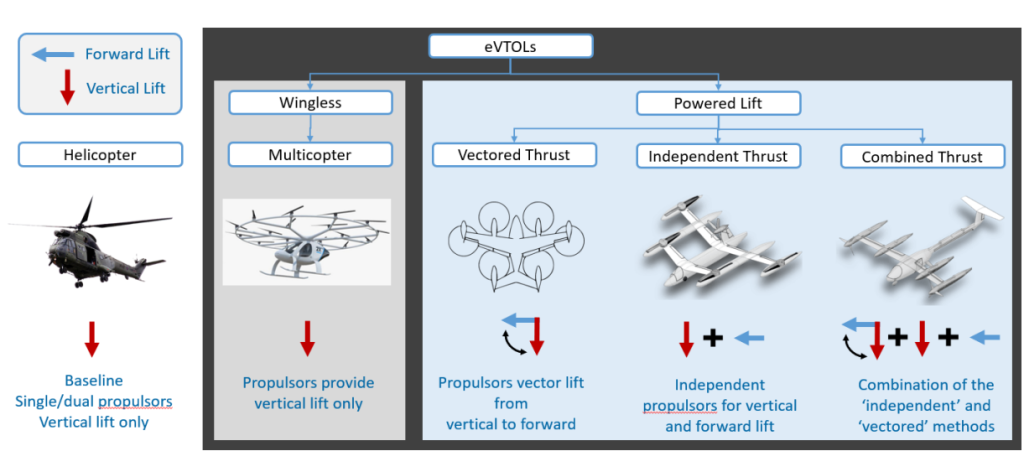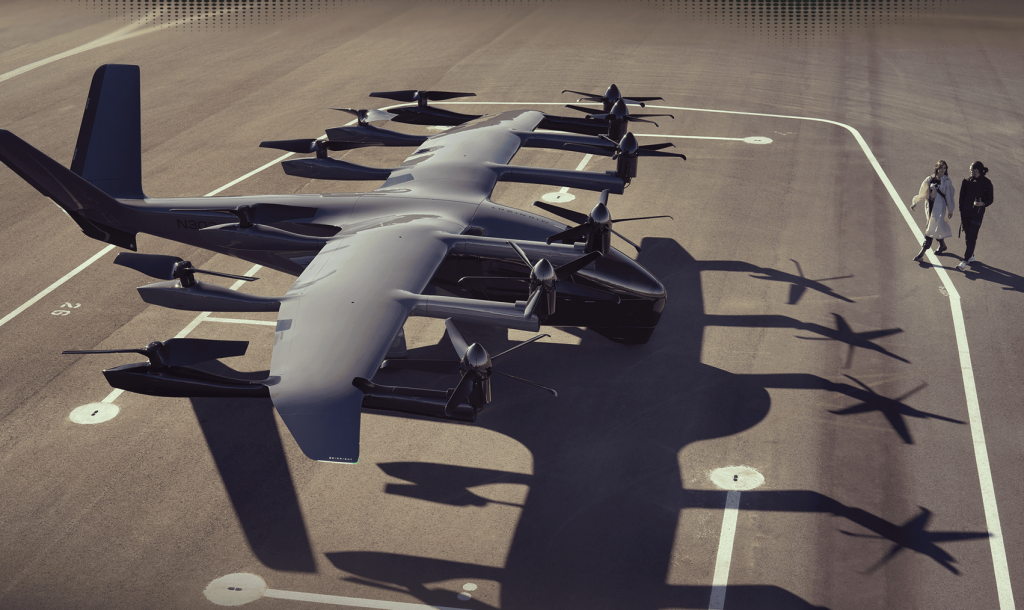In the rapidly evolving field of aviation, the emergence of electric Vertical Takeoff and Landing (eVTOL) aircraft represents a significant technological leap. Unlike traditional fixed-wing aircraft, eVTOLs offer the promise of urban air mobility, potentially revolutionizing how we think about personal and commercial transportation. However, the unique design and operational requirements of eVTOLs introduce new challenges, particularly in the realm of flight control. This newsletter delves into these challenges, examining why managing these futuristic aircraft is more complex and what this means for the future of aviation.

Figure 1: EVT Aerotechnics’s ET9
Challenges in eVTOL Flight Control
From the perspective of flight control, the vertical takeoff and landing fixed-wing configuration is more challenging compared to traditional fixed-wing aircraft because:
- eVTOLs commonly adopt Distributed Electric Propulsion (DEP), and the influence of the propulsion system on the airflow around the wings and fuselage is more complex.
- eVTOLs have more complex aerodynamic characteristics during the transition phase between takeoff/landing and cruise states.
- Traditional aircraft designs are more similar, and for some models, relatively accurate aerodynamic data can be derived solely based on empirical data. However, most eVTOL configurations are novel and vary greatly between configurations, making it impossible to rely on empirical data.

Figure 2: eVTOL Propulsion Configurations
Types of eVTOL Configurations
As for multirotor models, since their flight primarily relies on the rotation of the rotors rather than the aerodynamics of the wings, they can be controlled without needing precise aerodynamic models. Moreover, their flight control mode is consistent with the rotary wing phase of vertical takeoff and landing fixed-wing aircraft.
Based on different thrust configuration, eVTOL can be broken into several additional categories, each with unique characteristics that cater to different operational requirements and design philosophies.
- Vectored Thrust: The aircraft has wings and at least one vectored thruster that provides both lift and assists in cruising. The methods of achieving vectored thrust include, but are not limited to, tilt-wing, tilt-rotor, and tilt-duct.
- Compound Wing: The aircraft has wings and separate thrusters that provide lift and assist in cruising, respectively. During cruise, the aircraft relies on its wings, rather than the thrusters, to provide lift.
- Multirotor: The aircraft has multiple rotors and either no wings or short wings. During cruise, the aircraft also relies on the thrusters to provide all or part of the lift.
- Single Rotor Configuration: The aircraft has a single rotor and either no wings or short wings. During cruise, the aircraft also relies on the thruster to provide all or part of the lift, such as in the case of an electric helicopter or an electric autogyro.
More specifically, it can be summarized as:
| Primary Classification | Secondary Classification | Tertiary Classification |
| Powered Lift | Vectored Thrust (Same propulsion system for hover and forward flight) | Tilt Wing |
| Tilt Fan | ||
| Tilt Prop | ||
| Tilt Body Tilt Frame | ||
| Independent Thrust (Separate propulsion system for hover) | Lift + Cruise | |
| Slowed-Rotor Winged | ||
| Combined Thrust (Combined propulsion system for hover) | Tilt Wing | |
| Tilt Fan | ||
| Tilt Prop | ||
| Wingless | Multicopter | |
| Personal Aerial Vehicle | ||
| Electric Rotorcraft | ||
Adequate financial support has improved the research and development efficiency and product quality of companies. Since 2017, new models of products have been launched one after another. As shown in the table below, the latest products launched by the top financed companies all feature vectored thrust configurations. As a design that is more complex and has higher technical thresholds, the vectored thrust configuration enables products to achieve significant comparative advantages in terms of cruising speed and range.
| Company | Model | Structure | Year | Seat Numbers | Range (km) | Max Cruising Speed (km/h) |
|---|---|---|---|---|---|---|
| Archer | Midnight | Vectored Thrust | 2021 | 4 | 100 | 241 |
| AutoFlight | V1500M | Independent Thrust | 2022 | 4 | 250 | 200 |
| AutoFlight | Prosperity | Independent Thrust | 2023 | 5 | 250.3 | 200 |
| Beta Tech | Alia | Independent Thrust | 2020 | 6 | 463 | 271 |
| EHang | EH-216 | Multirotor | 2018 | 2 | 35 | 100 |
| EHang | VT-30 | Independent Thrust | 2021 | 2 | 300 | Unknown |
| EVE AIR MOBILITY | Eve | Independent Thrust | 2017 | 4 | Unknown | Unknown |
| Joby | S4 | Vectored Thrust | 2018 | 5 | 241 | 321 |
| Lilium | Jet | Vectored Thrust | 2019 | 7 | 250 | 280 |
| OVERAIR | Butterfly | Vectored Thrust | 2018 | 5 | 161 | 322 |
| VERTICAL AEROSPACE | VA-X4 | Vectored Thrust | 2020 | 4 | 161 | 241 |
| VOLOCOPTER | 2X | Multirotor | 2010 | 2 | 27 | 102 |
| VOLOCOPTER | Volocity | Multirotor | 2019 | 2 | 65 | 90 |
| VOLOCOPTER | Volo-Connect | Independent Thrust | 2021 | 4 | 97 | 250 |
| Wisk | Cora | Independent Thrust | 2018 | 2 | 100 | 180 |
| XPeng | Voyager X2 | Multirotor | 2021 | 2 | 75.8 | 130 |
The substantial financial support from the capital market has provided strong backing for the continuous technological innovation and rapid development of vertical takeoff and landing (VTOL) companies. For instance, Joby Aviation’s S4 VTOL model has passed FAA certification, and Lilium’s 7-Seater Jet has completed its first phase of flight testing, with both companies standing at the forefront of the sector in terms of their technological achievements and development progress. This underscores that the companies with the top financing amounts are leading in the VTOL aircraft market.

Figure 3: Archer’s Midnight eVTOL
When deciding which configuration to adopt for an eVTOL aircraft design, considerations from the control perspective are just one of the factors. During the aircraft design process, manufacturers also need to comprehensively consider various aspects such as aerodynamic efficiency, mechanical structure, maintainability, electrical characteristics, convenience, acoustic characteristics, aesthetics, and more. In addition to the aircraft design itself, manufacturers must also balance the technical implementation difficulty of the aircraft, supply chain management, airworthiness certification, and other factors to complete the product realization.
The preference for Lift + Thrust configurations among Chinese eVTOL companies can be attributed to the balance these designs offer between performance in vertical and forward flight, efficiency, and operational versatility. As the technology matures and more flight data becomes available, these configurations might evolve further to optimize different aspects of flight performance and operational economics.
References:
[1] Ugwueze, Osita & Statheros, Thomas & Horri, Nadjim & Innocente, Mauro & Bromfield, Mike. (2022). Investigation of a Mission-based Sizing Method for Electric VTOL Aircraft Preliminary Design. 10.2514/6.2022-1931.
[2] J. Kunzler, “When two worlds collide: What are Tiltrotor aircraft?,” Simple Flying, Dec. 05, 2023. https://simpleflying.com/tiltrotor-aircraft-guide/.
[3] “不同构型eVTOL飞控算法实现的挑战,” Boundaryai. https://www.boundaryai.cn/news/49.html.
[4] “全球EVTOL头部企业地理分布与融资概况,” 航空产业网. https://www.chinaerospace.com/article/show/985c5031147cd93e178707c9e3dfaf2b.
[5] “Archer.” https://archer.com/midnight
[6] “ET9,” EVT Aerotechnics. http://www.evt-aerotec.cn/index/index/et.html
Leave a Reply